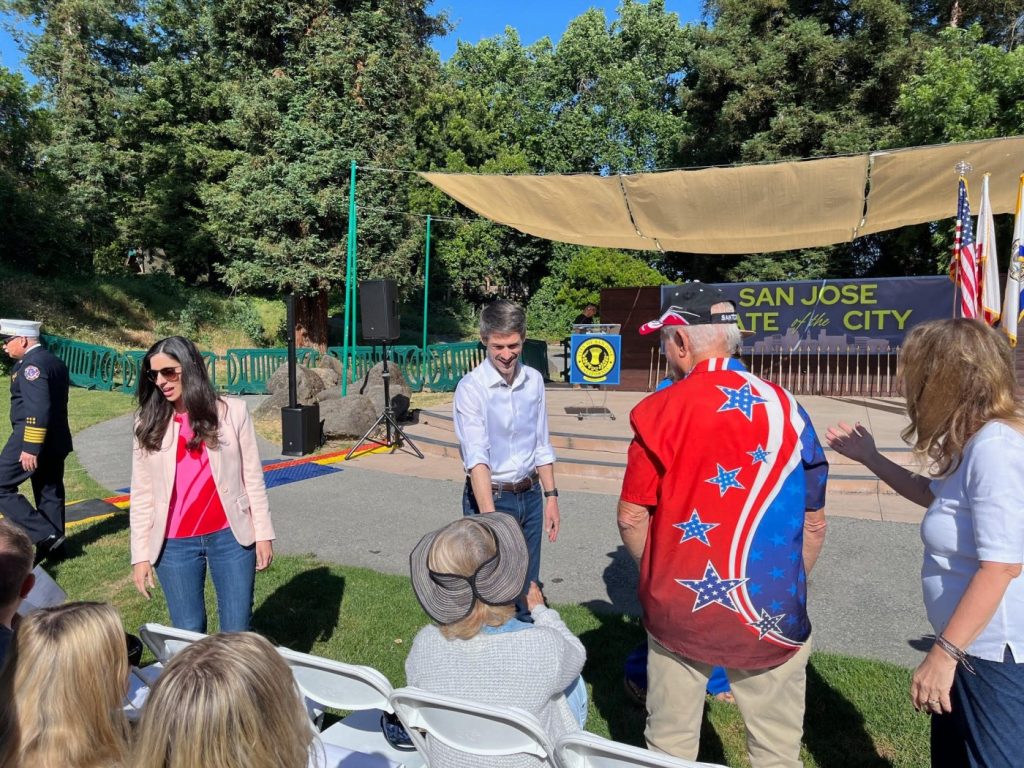San Jose must make a big push to tackle homelessness in the coming 12 months, San Jose Mayor Matt Mahan said Saturday, describing the problem as the “biggest crisis” that faces the Bay Area’s largest city.
He made the call to action in his annual State of the City speech, part of an event held in a meadow at San Jose’s Happy Hollow Zoo.
“Our biggest crisis, the humanitarian, environmental and fiscal crisis of homelessness” must be San Jose’s top priority, Mayor Mahan said during the State of the City speech.
“Over the next year, we will move over 1,000 additional people out of unsafe conditions who would otherwise continue to live on our streets and along waterways,” Mahan said, particularly the estimated 500 who are living next to waterways in “life-threatening situations.”
San Jose officials, including the city attorney, have raised the ominous prospect that the municipality could face fines and litigation from the Regional Water Board or other agencies regarding pollution and impact in waterways arising from nearby homeless encampments.
“At the end of the day, it’s pretty simple,” Mahan said during a press conference before the event. “We ought to provide safe, dignified places for people to be, and when they are available we ought to require that people come off the streets.”
Among the new solutions being considered: safe sleeping sites for homeless people, an approach that has begun to bear fruit in San Diego.
Still, the pathway is tricky at best, since San Jose must confront the forbidding reality of a $55 million budget shortfall in the coming weeks and months.
“We’re going to be more focused, more innovative, more practical than we’ve been in past years,” Mahan said in terms of how to craft solutions at a time when the city’s finances are being squeezed.
Mahan pointed to an initial estimate of $15 million for creation of a safe parking site in the Berryessa district. He noted that San Jose political leaders prodded city staffers, including the Public Works Department, to fashion a solution that shaved the cost in half.
The solutions will need to be numerous and wide-ranging, he said.
“Basic safe sleeping sites with sanitation and security and a connection to case management, safe parking, modular units, converted motel rooms, permanent affordable and permanent supportive housing,” are among the “spectrum of solutions” for homelessness, Mahan said during the press conference.
The mayor pointed to quick-build modular units that have helped to produce the first significant reductions in unsheltered homelessness in San Jose in a decade. Since 2017, prevention programs have kept nearly 4,000 households from homelessness in San Jose, he asserted.
Councilman Omar Torres, in an interview with this news organization after the event, pointed to signs of progress. “The whole toolbox that we are using to end homelessness is working, building affordable housing, building interim housing, cleaning up our streets, that is helping,” he said.
Over the next year, San Jose intends to more than double the number of the quick-build units by opening 628 of these new modular residences, including 150 sleeping cabins at Via Del Oro, the city’s first quick-build community on private land.
The city also aims to open a new safe parking site to move more than 100 live-in vehicles off the streets, the mayor said.
Progress in police recruitment is also being made, he said. “For the first time in five years, we’re seeing growing number of applicants to our San Jose Police Department academy. Our investments in outreach, recruitment and retention are beginning to pay off in something priceless, a safer city.”
Mahan also urged San Jose residents to embrace a spirit of volunteerism to help the city become cleaner, safer and more vibrant.
After the event, volunteers fanned out to an array of nearby locations to engage in tasks such as cleaning up Coyote Creek and sprucing up and beautifying Kelley Park, which is home to both Happy Hollow and the Japanese Friendship Garden.
Mahan pointed out that San Jose political leaders must soon pass a budget that’s balanced but also allows the city to tackle homelessness and meet the municipality’s environmental responsibilities.
“We are in this together,” Mahan said. “We may have different approaches, but ultimately we want a city that works, a city that works for all of us.”


